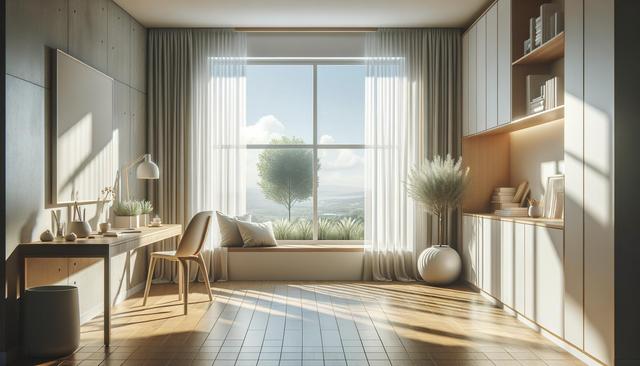Why Light Control Matters in Window Treatments
Managing natural light is one of the primary reasons people invest in window treatments. Whether it’s to reduce glare on screens, protect furniture from UV damage, or simply create a more comfortable atmosphere, the ability to control how much light enters a room is essential. Different types of window treatments offer varying levels of light filtration, from sheer panels that allow sunlight to gently diffuse into the room, to blackout curtains that block nearly all external light.
One of the key advantages of proper light control is its impact on energy efficiency. By choosing treatments that insulate your windows or reflect sunlight, you can reduce your reliance on artificial cooling and heating. Some popular options for light control include:
- Cellular shades that trap air and provide insulation
- Layered curtains with sheer and opaque panels
- Adjustable blinds with tilting slats
Each of these choices can be tailored to meet specific needs, whether you’re looking to brighten a dim room or darken a bedroom for better sleep. By evaluating the direction your windows face and the function of each room, you can select treatments that align with your light control preferences.
Balancing Privacy and Style
Privacy is another crucial factor when selecting window treatments. Especially in urban or closely-built residential areas, maintaining privacy without sacrificing style can be a challenge. Fortunately, there are numerous solutions that combine both. For example, frosted window films or top-down, bottom-up shades allow light to enter while obstructing the view from outside.
When choosing window coverings for privacy, consider the room’s purpose. Bedrooms and bathrooms typically require more coverage, while living rooms may allow for greater openness. Here are a few options that help strike the right balance:
- Roman shades with lined backing for increased opacity
- Venetian blinds that can be angled for selective viewing
- Layered drapes that allow for both sheer and heavy options
These styles not only provide coverage but also contribute to the overall aesthetic of the room. Neutral tones and textured fabrics can add warmth, while bold patterns or colors serve as focal points. The key is to ensure that the window treatment enhances the room’s design while serving its practical purpose.
Types of Window Treatments and Their Functions
There are many types of window treatments, each with unique benefits. Understanding the various options can help you choose the right fit for your home based on function, appearance, and maintenance. Common types include curtains, drapes, blinds, shades, and shutters, each offering different levels of light control and privacy.
Here’s a brief overview of their core features:
- Curtains: Lightweight and often used for decoration, they come in a variety of lengths, patterns, and materials.
- Drapes: Heavier than curtains, drapes are often lined and used to block out light and provide insulation.
- Blinds: Made of horizontal or vertical slats, they can be tilted or pulled up/down for light and privacy control.
- Shades: Fabric-based and available in various styles like roller, Roman, or cellular, offering a minimalist look.
- Shutters: Mounted to the window frame, these provide a classic look and excellent light and privacy control.
Each window treatment type can be customized to suit your taste and needs. For example, pairing blinds with sheer curtains can offer both functionality and a layered visual appeal.
Choosing the Right Materials
The material of your window treatments affects not only their appearance but also their performance in terms of light control, insulation, and durability. Fabrics like cotton and linen provide a soft, casual look and allow some natural light through, while heavier materials like velvet or brocade offer more privacy and insulation.
For high-moisture areas like kitchens and bathrooms, materials that resist mildew and are easy to clean—such as faux wood or vinyl—are practical choices. Energy-efficient fabrics, such as those used in cellular shades, can help regulate indoor temperatures by trapping air within their folds.
Here are some considerations when selecting materials:
- Climate: Choose insulating materials for colder environments and light-filtering ones for sunnier climates.
- Maintenance: Consider machine-washable fabrics for ease of cleaning.
- Style: Match textures and colors with your room’s decor for a cohesive design.
By thoughtfully selecting materials, you not only improve the functionality of your window treatments but also enhance the overall atmosphere of your living spaces.
Layering for Versatility and Aesthetic Appeal
Layering window treatments is an effective way to combine functionality with visual appeal. By using multiple types of coverings—such as blinds paired with curtains—you can adjust the level of light and privacy throughout the day while also creating a more dynamic interior design.
This method is especially useful in multifunctional rooms where lighting needs vary. For instance, a home office may require bright light during the day and privacy in the evening. A layered setup allows for flexibility and style without compromising on either.
Benefits of layering window treatments include:
- Enhanced insulation and energy efficiency
- Greater control over natural light and glare
- Increased privacy options
- Added depth and texture to your decor
Design-wise, layering opens up creative possibilities. You can mix patterns and solids, or combine different textures for a more sophisticated look. When done thoughtfully, layering not only meets practical needs but also elevates the ambiance of any room.
Conclusion: Creating a Comfortable and Stylish Home
Window treatments are more than just decorative elements—they are key to creating a comfortable, private, and energy-efficient home. From light control to privacy, the right combination of materials, styles, and installation methods can transform the look and feel of your interiors. Whether you’re updating a single room or redesigning your entire home, consider how each window treatment contributes to both function and flair. By evaluating your specific needs and preferences, you can select options that enhance both your lifestyle and your living space.




Leave a Reply